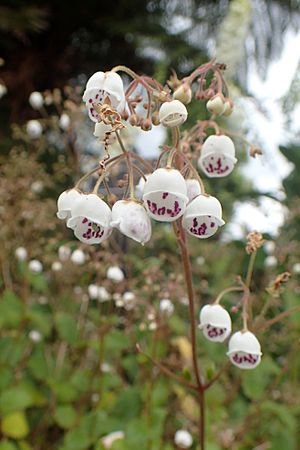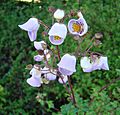Jovellana facts for kids
Quick facts for kids Jovellana |
|
|---|---|
 |
|
| Jovellana sinclairii, Auckland Botanic Gardens, New Zealand | |
| Scientific classification |
|
| Kingdom: | Plantae |
| Clade: | Tracheophytes |
| Clade: | Angiosperms |
| Clade: | Eudicots |
| Clade: | Asterids |
| Order: | Lamiales |
| Family: | Calceolariaceae |
| Genus: | Jovellana Ruiz & Pav. |
Jovellana is a group of beautiful flowering plants. They belong to the plant family Calceolariaceae. These plants used to be part of a different family called Scrophulariaceae. But scientists studied their DNA and found that the old family group wasn't quite right. It was like a family tree where some branches didn't actually connect. So, Jovellana and other similar plants were moved to new or existing plant families.
Contents
How Jovellana Plants Spread
Long, long ago, during a time called the Miocene epoch, the North Island of New Zealand had a warm, subtropical climate. Later, the climate started to cool down. It became more like the weather in central Chile today. Scientists think this change helped Jovellana plants from South America spread to New Zealand. They likely traveled a very long way, perhaps by seeds carried by wind or birds.
The Jovellana plants in South America and New Zealand are thought to have separated about 4.1 million years ago. The different types (species) within New Zealand and South America then started to become unique about 1 million years ago.
What Jovellana Plants Look Like
Jovellana plants are usually herbaceous (meaning they have soft stems, not woody ones) and are perennial (they live for more than two years). There are about six to eight different types, or species, of Jovellana. They grow naturally in Chile and New Zealand.
These plants have simple leaves. In the summer, they grow lovely sprays of bell-shaped flowers that hang downwards. Each flower has two lips. They come in colors like white, lilac, and purple. Inside, the flowers often have many spots of a different, contrasting color.
Here are some of the Jovellana species:
- Jovellana albula (found in Chile)
- Jovellana guentheri (found in Chile)
- Jovellana petiolaris (found in Chile)
- Jovellana punctata (found in Chile)
- Jovellana repens (found in New Zealand)
- Jovellana sinclairii (found in New Zealand)
- Jovellana sturmii (found in Chile)
- Jovellana violacea (found in Chile)
Where Jovellana Plants Grow
It's quite interesting that Jovellana plants are found in two places so far apart: Chile and New Zealand. This isn't the only plant group that does this. For example, the Fuchsia plant group also has species spread out in Central America, South America, New Zealand, and Tahiti. Scientists study these patterns to understand how plants have traveled and evolved over millions of years.
Growing Jovellana Plants in Gardens
At least three types of Jovellana are grown in gardens because they are so pretty. They can handle cold weather down to about -5 degrees Celsius (23 degrees Fahrenheit). However, if you want to grow them, they need a spot that is protected from strong winds and gets lots of sunshine.
One popular type is Jovellana violacea. It can grow up to 2.5 meters (about 8 feet) tall and 1 meter (about 3 feet) wide. It's a semi-evergreen plant, meaning it keeps some of its leaves all year. Its flowers are lilac-colored with purple spots on a yellow background inside. This plant has even won an Award of Garden Merit from the Royal Horticultural Society, which means it's a great plant for gardens!
Gallery
-
Jovellana repens's growth form
See also
 In Spanish: Jovellana para niños
In Spanish: Jovellana para niños






